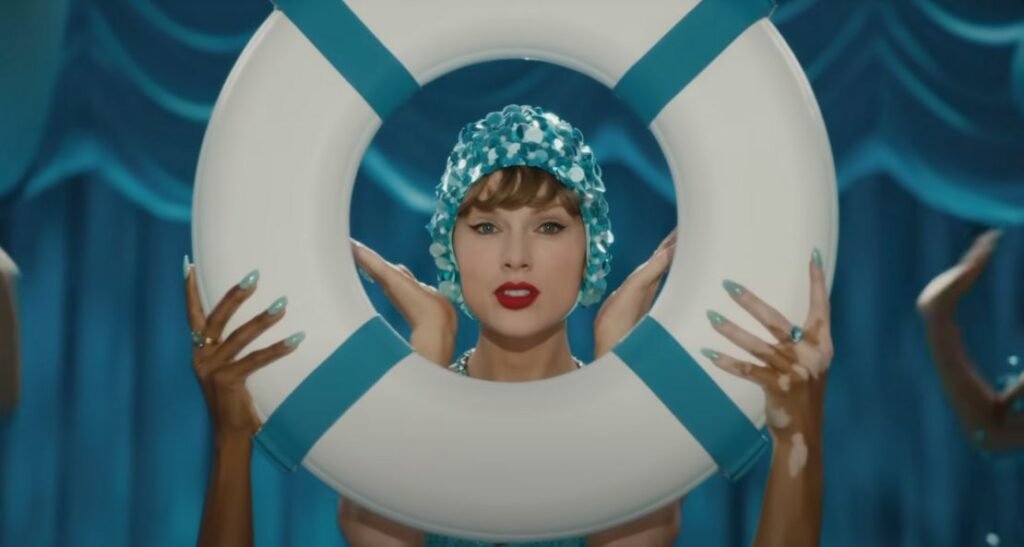“The Fate of Ophelia” opens The Life of a Showgirl with Taylor Swift doing what she does best: taking a cultural touchstone everyone half-remembers from high school English and making it about her. And honestly? It works.
The song itself is pure Max Martin gloss. That springy bassline, the way Swift’s voice sits low in the verses before the chorus cracks open wide.
At 3:46, it’s tight enough to avoid overstaying its welcome, which is more than you can say for some of her recent album openers. This is Swift in full 1989 mode: synth-pop that sparkles without apologizing for it.
But let’s talk about what she’s actually doing here. Ophelia drowns in Hamlet. Swift’s version? She swims.
The whole song is built on this rescue fantasy (you saved me from going under), and depending on your tolerance for Swift’s particular brand of romantic mythology, you’ll either find it swoonworthy or eyeroll-inducing. I’m somewhere in the middle.
There’s something compelling about reclaiming a symbol of feminine tragedy, sure, but Swift’s been playing the saved-by-love card for years now.
At some point, Ophelia stops being Shakespeare and starts being another costume in the dress-up box.
The music video makes this literal. Swift directed it herself (of course), and it’s a one-take fever dream through speakeasy stages, that Millais painting everyone knows, and nine (nine!) costume changes.
The internet’s already calling it her “showgirl era,” which feels both inevitable and slightly exhausting. Yes, it’s gorgeous. Yes, the bath scene echoes the album art. Yes, every frame is a mood board Pinterest would die for.
But there’s a nagging question underneath all that opulence: when does pastiche become personality?
Here’s where I’ll give Swift credit: she knows exactly what she’s doing. The fan discourse is already fracturing into predictable camps.
Some call it “empowerment.” Shakespeare scholars shrug and say artists have been remixing Ophelia for centuries.
A vocal minority on Reddit wishes the production would breathe a little. All of this is by design. Swift builds songs that function as Rorschach tests. You see what you bring to them.
Musically, there’s craftsmanship here that shouldn’t be dismissed. That verse-to-chorus lift, the way the melody stays sticky while the lyrics do their cryptic work… it’s Martin and Shellback operating at the level that made “Blank Space” undeniable.
Swift’s smart enough to let them cook while she handles the literary Easter eggs. The line between “fate” and “choice” runs through the whole thing: if you show up, I won’t go under. It’s a pact dressed as a pop song, which is vintage Swift.
But I keep coming back to the core question: does rewriting Ophelia’s ending actually give her agency, or does it just swap one symbol for another?
Swift escapes the tragic heroine role by… becoming the rescued heroine. That’s not nothing, but it’s not exactly radical either.
The showgirl framing gives her permission to be theatrical, to lean into excess and spectacle. Fine. Great, even. But theatricality is not the same as transformation.
What saves “The Fate of Ophelia” from collapsing under its own references is that it’s genuinely catchy.
You can argue about the semiotics all day, and people will, but the song succeeds first as a pop object.
It’s an opener that does what openers should: it sets a tone, announces an aesthetic, and gets stuck in your head.
Whether that tone is empowering or just expensive depends on how much you’re willing to invest in Swift’s personal mythology.
Me? I’ll take the song. I’m less convinced by the iconography. But maybe that’s the point. Swift’s always worked best when you can hum along while rolling your eyes.
“The Fate of Ophelia” doesn’t drown, but it doesn’t exactly break new ground either. It floats, glamorously, exactly where Swift wants it to.
You might also like:
-
Taylor Swift — “All Too Well” lyrics meaning and short-film breakdown
-
Taylor Swift — “August” explained: why it returns every summer
-
Taylor Swift — “Anti-Hero” lyric deep dive and video analysis
-
Chappell Roan — “The Subway” review: public heartbreak, huge refrain
-
Olivia Rodrigo — “Obsessed” breakdown: sharp, darker pop cut


